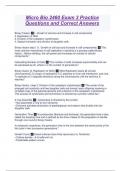Exam (elaborations)
Micro Bio 2460 Exam 3 Practice Questions and Correct Answers
- Course
- Institution
Binary Fission 1. Growth of cell size and increase in cell components 2. Replication of DNA 3. Division of the cytoplasm (cytokinesis) 4. Septum formation and division of daughter cells Binary fission step 1 (1. Growth of cell size and increase in cell components) "The most common mechanism of cel...
[Show more]



